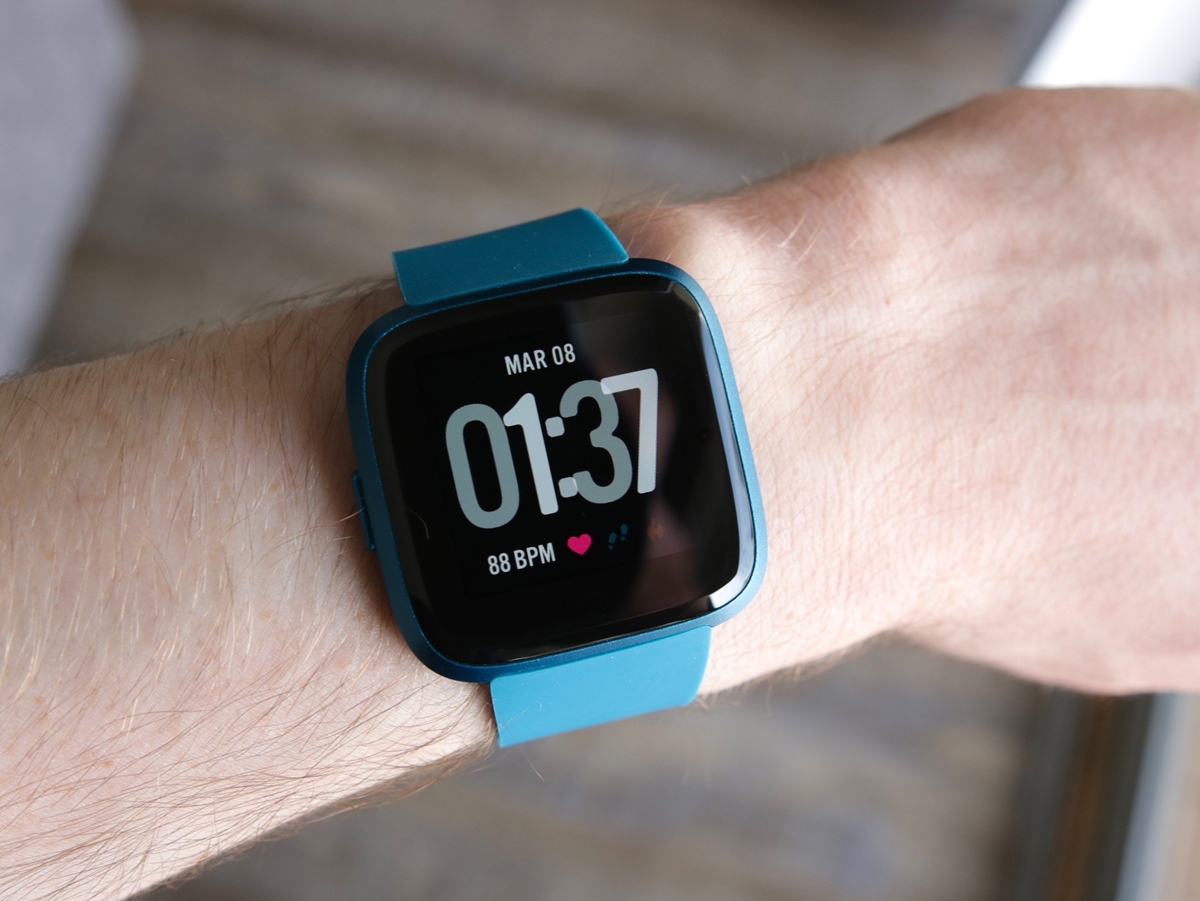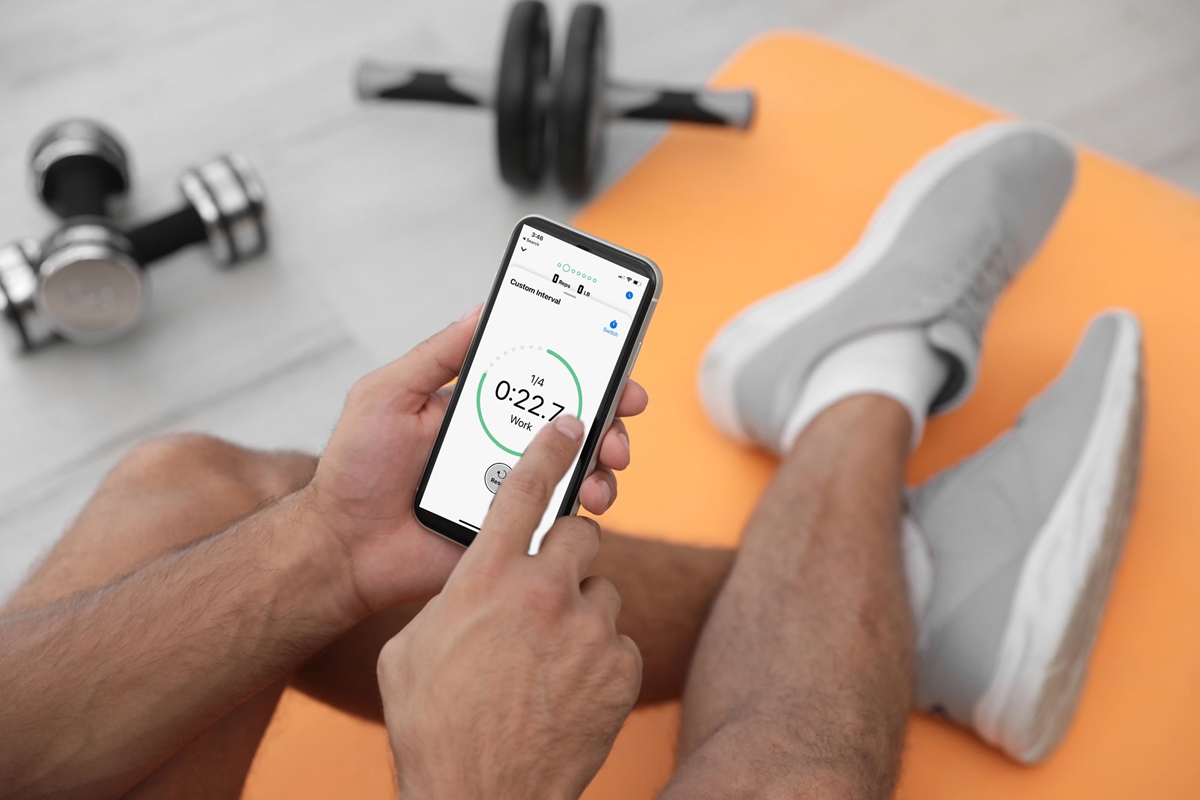Home>Misc>Featured>How To Secure Smartphone While Interval Training


Featured
How To Secure Smartphone While Interval Training
Modified: August 19, 2023
"Discover the best tips and tricks to keep your smartphone secure during your interval training sessions with our featured guide. Protect your phone and focus on your workout!"
Introduction
Smartphones have become an integral part of our lives, offering us convenience and connectivity at our fingertips. From communication to entertainment, smartphones provide a wide range of features that make our daily routines more efficient. However, with this convenience comes the risk of cybersecurity threats and the need to secure our devices.
In today’s digital world, the importance of securing our smartphones cannot be overstated. With the increasing number of cybercrime incidents and data breaches, it is more crucial than ever to take proactive steps to protect our personal information, sensitive data, and online privacy from potential malicious attacks.
When engaging in high-intensity activities like interval training, it is easy to overlook the security of our smartphones. However, it is essential to prioritize device security even during workouts, to prevent unauthorized access to our personal data and ensure our smartphones remain protected.
In this article, we will discuss various methods and measures to secure your smartphone while engaging in interval training. By implementing these strategies, you can minimize the risk of compromising your device’s security and enjoy your workouts with peace of mind.
Understanding the Risks
Before diving into the strategies for securing your smartphone while interval training, it is crucial to understand the potential risks involved. By being aware of these risks, you can better understand the importance of implementing security measures and take appropriate actions to safeguard your device.
One of the main risks is the possibility of physical damage to your smartphone during intense workouts. Interval training often involves rigorous movements and high impact exercises that can lead to accidental drops or damage. This can not only affect the functionality of your device but also potentially expose your data if the device becomes compromised.
Another risk to consider is the potential for theft. Interval training often takes place in public spaces like gyms or parks, and leaving your smartphone unattended or easily accessible can make it an easy target for thieves. The loss of your device can not only result in financial loss but also put your personal information and sensitive data at risk if it falls into the wrong hands.
In addition to physical risks, there are also cybersecurity threats to be aware of. Malicious actors can exploit vulnerabilities in your smartphone’s software or trick you into downloading malicious applications or clicking on suspicious links. This can lead to unauthorized access to your personal information, financial data, and even control over your device.
Understanding these risks emphasizes the need for implementing security measures to protect your smartphone during interval training. By doing so, you can minimize the chances of physical damage, theft, and cybersecurity breaches, ensuring the safety of your device and your personal data.
Setting up a Secure Lock Screen
A secure lock screen is the first line of defense for your smartphone. It prevents unauthorized access and ensures that only you can unlock your device. When interval training, it is important to have a secure lock screen in place to protect your personal data.
Start by setting up a strong passcode or pattern lock on your smartphone. Avoid using easily guessable patterns or common passcodes like “1234” or your birthdate. Opt for a combination of characters, numbers, and symbols to enhance the complexity of your lock screen.
If your smartphone offers biometric authentication options such as fingerprint or facial recognition, enable these features for an added layer of security. Biometric authentication methods are more secure than traditional passcodes or patterns, as they are unique to you and difficult to replicate.
Another important feature to consider is the option to erase data after a certain number of failed login attempts. Enabling this feature ensures that if someone tries to guess your passcode repeatedly, the device will automatically wipe its data, minimizing the risk of unauthorized access.
In addition, consider adjusting the lock screen timeout settings. This feature determines how quickly your smartphone’s screen will lock after inactivity. Shortening the timeout period ensures that even if you accidentally leave your device unattended during your workout, it will lock itself quickly, reducing the risk of someone gaining access to your data.
Remember to regularly update and change your lock screen credentials to maintain optimal security. Avoid sharing your passcode or biometric information with anyone and be cautious when entering your credentials in public or crowded areas.
By setting up a strong and secure lock screen, you can ensure that your smartphone remains protected during interval training, preventing unauthorized access to your personal data and maintaining your privacy.
Installing a Reliable Antivirus App
Installing a reliable antivirus application on your smartphone is crucial for protecting your device against malware and other cyber threats. While many people associate antivirus software with computers, it is equally important to have such protection on your smartphone, especially when engaging in interval training.
Look for antivirus apps that have a proven track record and positive reviews from reputable sources. These applications should offer real-time scanning and protection, detecting and removing malicious software that might be hidden in downloaded apps or files. Additionally, they should provide regular updates to ensure they stay up-to-date with the latest threats.
Make sure the antivirus app you choose includes features like app scanning, which scans and examines the apps installed on your device for any signs of malware or suspicious behavior. It should also have a web protection feature that helps detect and block phishing attempts or malicious websites that you might encounter while browsing the internet.
Another essential feature to consider is the ability to remotely locate and wipe your smartphone in case it is lost or stolen. This feature is particularly useful during interval training when your device might be vulnerable to theft. By remotely wiping your smartphone, you can prevent unauthorized access to your personal data.
Dedicate some time to configure the antivirus app’s settings according to your preferences and needs. Determine if you want the app to automatically scan new app installations or files, or if you prefer to initiate manual scans. You can also specify scanning schedules to minimize interruptions during your workouts.
Remember to keep your antivirus app updated regularly. Developers continually release updates to address new threats, improve performance, and enhance security features. By keeping your antivirus app up-to-date, you can ensure your smartphone remains protected from the latest malware and cybersecurity risks.
By installing a reliable antivirus app, you can add an extra layer of protection to your smartphone while interval training. This will help safeguard your device and personal data from potential malware, providing peace of mind that your information is secure.
Securing Your Mobile Network Connection
Securing your mobile network connection is essential to protect your smartphone and data while interval training. By following these steps, you can enhance the security of your network connection and minimize the risk of unauthorized access or data breaches.
First and foremost, avoid connecting to public Wi-Fi networks when accessing sensitive information or performing tasks that involve personal data. Public Wi-Fi networks are often unsecured, making it easier for hackers to intercept data transmitted over these networks. Instead, use your mobile data connection or consider setting up a personal hotspot on your smartphone for a secure internet connection.
When using your mobile data connection, ensure that you have a strong and reliable signal. Weak signals can lead to slower connection speeds and potential security vulnerabilities. Position yourself in areas with good network coverage to maintain a stable and secure connection during your workouts.
Consider encrypting your internet traffic by using a virtual private network (VPN) service. A VPN creates a secure and encrypted connection between your smartphone and the internet, protecting your data from being intercepted or monitored. Look for trusted VPN providers and activate the VPN on your device before starting your workout.
Regularly monitor your smartphone for any suspicious or unauthorized network activity. Check your device’s network settings for any unfamiliar Wi-Fi networks or unauthorized Bluetooth connections. If you notice anything unusual, disable the network or Bluetooth immediately to prevent potential security breaches.
Another important step to secure your mobile network connection is to enable the firewall feature on your smartphone. Firewalls monitor incoming and outgoing network traffic, helping to block unauthorized access and potential threats. Check your device’s settings to ensure the firewall is enabled and properly configured.
Finally, be cautious when downloading or accessing content from unfamiliar or unreliable sources. Stick to trusted app stores and official websites to minimize the risk of downloading malicious apps or files. Avoid clicking on suspicious links or pop-up advertisements that can lead to potential security breaches or phishing attempts.
By following these steps, you can secure your mobile network connection during interval training, ensuring your smartphone and personal data remain protected from potential threats and unauthorized access.
Enabling Two-Factor Authentication
Enabling two-factor authentication (2FA) is a crucial step in securing your smartphone during interval training. This additional layer of security provides an extra barrier against unauthorized access to your personal data and accounts.
Two-factor authentication requires users to provide two forms of identification to access their accounts. Typically, it involves something you know (like a password) and something you have (like a unique verification code). This verification code is often sent to your smartphone through a text message, a dedicated app, or email.
To enable 2FA, first, identify the accounts or apps that provide this feature. Many popular online services, social media platforms, and financial institutions offer 2FA options to enhance security. Access the account settings of each relevant app or service and enable 2FA.
Most 2FA implementations involve installing an authentication app on your smartphone, such as Google Authenticator or Authy. These apps generate unique and time-sensitive verification codes that you must enter when logging in to your accounts, providing an extra layer of security.
Make sure to securely store backup codes provided by the authentication app. These backup codes act as temporary alternatives to verify your identity if you can’t access the authentication app for any reason. Store them in a secure location or use a password manager app to keep them safe.
It is also important to regularly review and select strong and unique passwords for your accounts, as 2FA should complement a strong password, not replace it. Avoid using easily guessable passwords and consider using a password manager to generate and store complex and unique passwords for each account.
Keep your smartphone locked with a secure lock screen and do not share your authentication app or verification codes with anyone. By implementing 2FA and following best practices for password security, you significantly reduce the risk of unauthorized access to your accounts.
Remember that enabling 2FA may require additional steps when logging in to your accounts. While it may seem slightly inconvenient, the added security and protection it provides outweigh the minor inconvenience.
By enabling two-factor authentication, you add an extra layer of security to your smartphone during interval training, minimizing the risk of unauthorized access to your personal data and accounts.
Avoiding Suspicious Apps and Links
One of the most important steps in securing your smartphone during interval training is avoiding suspicious apps and links. Malicious apps and phishing links can lead to potential security breaches and compromise your personal data. Here are some essential tips to help you stay safe:
Be cautious when downloading apps from third-party sources. Stick to official app stores such as the Apple App Store or Google Play Store, as they have strict security measures in place to minimize the risk of downloading malicious apps. Read app reviews and check the developer’s credibility before installing any application.
Pay attention to app permissions. Review the permissions requested by apps before installing them. Be cautious if an app requests unnecessary access to your personal data, contacts, or device features. If the requested permissions seem excessive or suspicious, consider an alternative app or seek clarification from the app developer.
Avoid clicking on suspicious links that you receive via email, text message, or social media platforms. Phishing links are designed to deceive you into providing your personal information or downloading malware onto your device. Exercise caution and verify the legitimacy of the link before clicking on it.
Double-check the URLs of websites that you visit. Malicious actors may create websites that resemble popular platforms or services to deceive users. Look for slight differences in the URL spelling or structure, and ensure the website has a secure connection (https://) before entering any personal information.
Consider using a reputable web browser that offers built-in security features. These browsers often have built-in blockers for malicious websites and can detect and warn you about potentially harmful links. Keep the browser and its security features up to date to ensure optimal protection.
Install an ad-blocking app or browser extension to reduce the likelihood of clicking on malicious ads or pop-ups that may lead to security breaches. Ad blockers can help prevent potentially harmful scripts or ads from being displayed on your device.
Regularly update your apps and operating system. Developers frequently release updates to patch security vulnerabilities and protect against emerging threats. Enable automatic updates on your smartphone to ensure you have the latest security measures in place.
Lastly, exercise caution when using public Wi-Fi networks. Public networks are often unsecured and can be compromised by hackers. Avoid accessing sensitive information or performing financial transactions while connected to public Wi-Fi and consider using a VPN for an extra layer of protection.
By avoiding suspicious apps and links, you minimize the risk of falling victim to malware infections, phishing attempts, and unauthorized access to your personal data. Staying vigilant and exercising caution when downloading apps or clicking on links is crucial for maintaining the security of your smartphone during interval training.
Regularly Updating Your Smartphone’s Software
Regularly updating your smartphone’s software is crucial for maintaining optimal security and protecting your device during interval training. Software updates often include important security patches, bug fixes, and performance improvements that help safeguard your device from potential vulnerabilities and attacks.
When a software update becomes available, it is essential to install it as soon as possible. These updates are designed to address known security issues and protect against new threats that may arise. Delaying or ignoring updates increases the risk of your device being targeted by hackers or malware.
Enable automatic updates on your smartphone to ensure that you receive the latest software updates without having to manually check for them. Automatic updates ensure that you are always running the most up-to-date version of the operating system and other essential components.
In addition to operating system updates, it is crucial to keep your apps up to date as well. Developers frequently release updates that address security vulnerabilities and improve the functionality and performance of their apps. Enable automatic app updates or regularly check for updates manually to ensure that you have the latest versions installed.
When updating your smartphone’s software, ensure that you are connected to a secure network, preferably your home Wi-Fi or a trusted cellular network. Avoid public Wi-Fi networks as they can be vulnerable to hackers and increase the risk of unauthorized access or data interception during the update process.
Regularly backing up your smartphone’s data is an important step to take before initiating a software update. Although rare, there is always a chance that something could go wrong during the update process, potentially causing data loss. By regularly backing up your data, you can restore it if any issues arise during the update.
Software updates not only enhance security but also improve the overall performance and stability of your smartphone. By keeping your device up to date, you can enjoy a more efficient and reliable user experience, allowing you to focus on your interval training without any interruptions or slowdowns.
Remember that updates may occasionally introduce new features or changes to the user interface. Take some time to familiarize yourself with any changes and explore new features that may be beneficial to your smartphone usage.
By regularly updating your smartphone’s software, you significantly reduce the risk of security vulnerabilities and ensure that your device is equipped with the latest protections. Stay proactive in keeping your device up to date, and you can confidently use your smartphone during interval training, knowing that it is well-secured and optimized for performance.
Encrypting Your Smartphone’s Data
Encrypting your smartphone’s data is a crucial step in securing your device during interval training. Encryption converts your data into an unreadable format, making it inaccessible to anyone without the appropriate encryption key. By encrypting your smartphone’s data, you add an extra layer of protection against unauthorized access.
Most modern smartphones offer built-in encryption features that can be easily enabled in the device settings. The encryption process may take some time, so ensure that your device is fully charged or connected to a power source before initiating encryption.
When encrypting your device, your data, including contacts, messages, photos, and app data, is scrambled and can only be accessed with the correct encryption key or password. This means that even if your device falls into the wrong hands, your data remains protected, minimizing the risk of identity theft or exposure of sensitive information.
It is important to set a strong and unique password or passphrase for your device’s encryption. Avoid using easily guessable passwords and consider using a combination of letters, numbers, and symbols to enhance the security of your encryption key.
Remember that encryption protects your data when your device is powered off or locked. However, once your device is unlocked, the encrypted data is accessible. Therefore, it is crucial to keep your lock screen secure by using a strong password or biometric authentication.
Regularly back up your data before enabling encryption. While rare, there is a slight risk of data loss during the encryption process. By backing up your data, you can restore it if any issues occur during encryption or if you need to reset your device in the future.
Encrypting your smartphone’s data ensures that your personal information and sensitive data remain secure, even if your device is lost or stolen during interval training. It is an essential step in protecting your privacy and preventing unauthorized access to your data.
Be aware that encrypted data may take longer to access and can slightly impact your device’s performance. However, the added security benefits outweigh the minor inconvenience.
Lastly, remember to keep your encryption password or passphrase confidential and never share it with anyone. This helps maintain the integrity and security of your encrypted data. If you suspect that your encryption password has been compromised, change it immediately to ensure continued protection.
By encrypting your smartphone’s data, you can rest assured that your personal information remains private and secure during interval training.
Using Secure Messaging Apps
Utilizing secure messaging apps is essential to protect your communication and maintain privacy while interval training. These apps offer end-to-end encryption, preventing unauthorized access to your messages and ensuring that they remain secure and private.
When choosing a secure messaging app, look for ones that prioritize encryption and have a strong reputation for protecting user privacy. Popular options include Signal, WhatsApp, Telegram, and Wickr. These apps employ strong encryption protocols that make it virtually impossible for anyone, including hackers or government agencies, to intercept and decrypt your messages.
End-to-end encryption means that your messages are encrypted on your device and can only be decrypted by the intended recipient. Even the app provider does not have access to the content of your messages. This ensures that your conversations are kept confidential and prevents any unauthorized entities from reading your messages.
Make sure to enable any additional security features offered by the messaging app, such as two-factor authentication or biometric authentication. These features provide an extra layer of protection by ensuring that only authorized users can access your messages.
Avoid using unsecured or unknown messaging apps that do not offer strong encryption or have a questionable track record when it comes to user privacy. These apps may not adequately protect your messages and could potentially expose your conversations to unwanted scrutiny.
When communicating with others, verify their identities to ensure that you are exchanging messages with the intended recipients. Avoid sharing sensitive or personal information through messaging apps unless you are confident in the security measures provided by the app.
Regularly update your messaging apps to benefit from the latest security features and bug fixes. Developers often release updates to address vulnerabilities and improve overall app security. Enable automatic updates or check for updates manually to ensure you are running the most up-to-date version of the app.
It is also important to be cautious when sending media files or attachments through messaging apps. Malicious files can carry malware or other threats that can compromise your device’s security. Only download and open files from trusted sources or use additional security measures like antivirus scans to further protect your device.
By using secure messaging apps, you can have peace of mind knowing that your conversations are protected and your privacy is maintained during interval training. These apps offer strong encryption and security features that minimize the risk of unauthorized access to your messages and ensure the confidentiality of your communication.
Backing up Your Data
Backing up your data is a crucial step in securing your smartphone during interval training. Data loss can occur due to various reasons, such as device theft, accidental damage, or software glitches. By regularly backing up your data, you can protect your valuable information and ensure that it can be easily restored if needed.
There are multiple methods to back up your smartphone’s data. One common option is to use cloud storage services offered by providers like Google Drive, Apple iCloud, or Dropbox. These services allow you to upload and store your data securely on remote servers, accessible from any device with an internet connection.
Ensure that the cloud storage service you choose offers robust security measures, such as encryption and password protection, to protect your data from unauthorized access. Set up automatic backups, if available, to ensure that your data is regularly synced and updated in the cloud.
Additionally, you can back up your data locally using your device’s built-in backup feature or third-party backup applications. Local backups typically involve creating a copy of your data on your computer or an external storage device, such as an external hard drive or USB stick.
Remember to secure your backups by using strong passwords or encryption whenever possible. This helps ensure that even if someone accesses your backups, they won’t be able to access your data without the necessary credentials.
When backing up your data, prioritize essential information such as contacts, photos, videos, documents, and any other important files. Consider the specific needs and content on your device to determine what is crucial to back up.
Make it a habit to regularly perform backups to ensure that you have the most recent version of your data stored safely. Set reminders or use backup scheduling options provided by cloud storage services or backup applications to automate the process.
Test your backups periodically by restoring your data from the backup source. This ensures that the backup files are complete and accessible, giving you peace of mind knowing that your data is properly backed up and can be recovered if needed.
Remember, your smartphone can get damaged or lost at any time, so backing up your data is vital for protecting your irreplaceable information and memories.
By consistently backing up your data, whether through cloud storage services or local backups, you can ensure that your information remains safe and easily recoverable, even in the event of unforeseen circumstances.
Conclusion
Securing your smartphone while interval training should be a top priority to protect your personal information and ensure the privacy of your data. By implementing the strategies outlined in this article, you can minimize the risk of cyber threats and unauthorized access to your device.
Start by setting up a secure lock screen with a strong passcode or biometric authentication. This prevents unauthorized access to your smartphone during workouts. Installing a reliable antivirus app helps detect and remove malware, providing an extra layer of protection.
Securing your mobile network connection is crucial, particularly when accessing sensitive information. Avoid public Wi-Fi networks and consider using a VPN for a secure internet connection. Enabling two-factor authentication adds an extra barrier against attackers attempting to access your accounts.
Avoiding suspicious apps and links helps prevent malware infections and phishing attempts. Regularly updating your smartphone’s software ensures that you have the latest security patches and performance improvements. Encrypting your smartphone’s data protects your personal information and sensitive data from unauthorized access.
Using secure messaging apps with end-to-end encryption safeguards your communication, keeping your messages private. Don’t forget to regularly back up your data to protect against data loss and ensure easy recovery in case of a device mishap.
Remember, securing your smartphone is an ongoing task. Stay vigilant, follow best practices, and remain up-to-date with the latest security measures and techniques. By prioritizing security while interval training, you can enjoy your workouts with peace of mind, knowing that your smartphone and personal data are well-protected.




